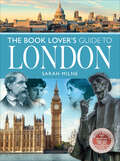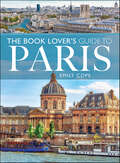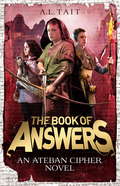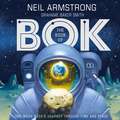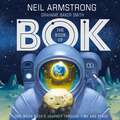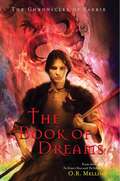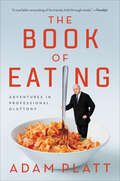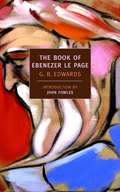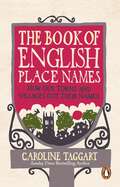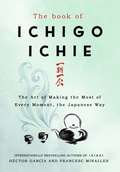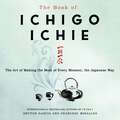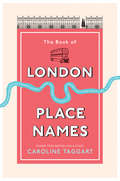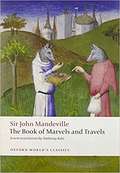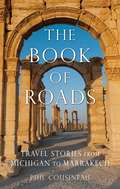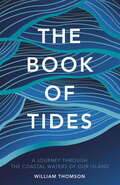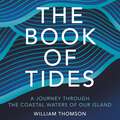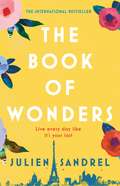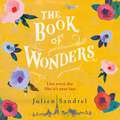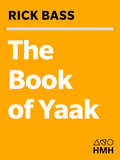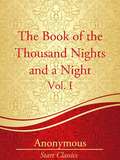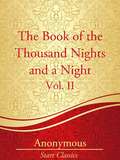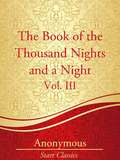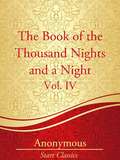- Table View
- List View
The Book Lover's Guide to London (City Guides)
by Sarah Milne&“Brings literature lovers on a journey through London, from Chaucer in the fourteenth century to present day . . . as diverse as the city itself.&” —British Heritage Travel Many of the greatest names in literature have visited or made their home in the colorful and diverse metropolis of London. From Charles Dickens to George Orwell, Virginia Woolf to Bernadine Evaristo, London&’s writers have brought the city to life through some of the best known and loved stories and characters in fiction. This book takes you on an area-by-area journey through London to discover the stories behind the stories told in some of the most famous novels, plays, and poems written in, or about, the city. Find out which poet almost lost one of his most important manuscripts in a Soho pub. Discover how Graham Greene managed to survive the German bomb that destroyed his Clapham home. Climb down the dingy steps from London Bridge to the Thames Path below and imagine how it felt to be Nancy trying to save Oliver Twist, only to then meet her own violent death. Drink in the same pub where Bram Stoker listened to the ghost stories that inspired Dracula, the plush drinking house where Noel Coward performed, and the bars and cafes frequented by modern writers. Tour the locations where London&’s writers, and their characters lived, worked, played, loved, lost, and died. This is the first literature guide to London to be fully illustrated throughout with beautiful color photographs. It can be used as a guidebook on a physical journey through London, or as a treasury of fascinating, often obscure tales and information for book lovers to read wherever they are.
The Book Lover's Guide to Paris (City Guides)
by Emily CopeA must-have for every fan of literature and Paris. The Book Lover's Guide to Paris is an extensive and informative travel companion, shedding new light on an ever-popular subject and spanning three centuries of the city's unique literary history, from Victor Hugo's Paris to the Lost Generation literati and present-day works such as Dan Brown's The Da Vinci Code. Includes unique, full-color photographs to reveal the settings readers have imagined in their favorite books, as well as insights into to lives, literature, haunts and homes of some of the world's best writers. This guide will enable book lovers to explore the abundance of literary history Paris has to offer, as well as making the most of the city itself.
The Book of Answers: The Ateban Cipher Book 2 - from the bestselling author of The Mapmaker Chronicles (The\ateban Cipher Ser.)
by A. L TaitAn orphan in exile. A band of rebel girls. And a prince whose throne has been stolen. Come on a journey full of danger, intrigue, adventure and incredible secrets.'The Ateban Cipher,' Lucien continued, 'is also known as the Book of Answers.''Answers to what?' Eddie asked.Lucien sighed. 'Everything.In the second gripping Ateban Cipher novel, Gabe and his companions journey to a remote mountain citadel where they learn the secret of the mysterious, encrypted book that Gabe has been tasked with protecting. But their enemies are close behind them, and new dangers lie ahead.As Eddie seeks to regain his crown, and Merry and Gwyn race to free their father, Gabe will discover the answer to his own great mystery - his true identity.'an exciting adventure read and an immersive story' ***** SUNDAY TELEGRAPH on THE ATEBAN CIPHER 1: THE BOOK OF SECRETStheatebancipher.com
The Book of Bok: One Moon Rock's Journey Through Time and Space
by Neil ArmstrongFirst man on the Moon Neil Armstrong reveals the adventure of the first Moon landing, and how the Earth and the Moon came to be, in this unique non-fiction picture book.A young boy sits up in bed and gazes at the distant Moon through his window. He wonders if, one day, a human will stand on its surface and look back at the Earth. But Earth is already being studied from the Moon. An all-seeing Moon rock of almost impossible age, called Bok, has been looking down at our blue and green planet for millennia.Geologists - people who study rocks - have a saying: 'Rocks remember'. During his time, Bok has witnessed some truly wondrous things. Created in the Earth-shattering collision 4.5 billion years ago that led to the formation of the Moon, he has seen stars burst into being and meteors streak through the solar system. He has seen his own Moon surface be transformed with craters, and he has watched a fiery, volcanic planet transform into the haven we know today - as mountain ranges rose up, oceans appeared and dinosaurs roamed the Earth.And he found himself rudely awoken one early lunar morning by a strange creature picking him up and throwing him into a box. That is how Bok and Neil Armstrong first met, and this is their (true) story.
The Book of Bok: One Moon Rock's Journey Through Time and Space
by Neil ArmstrongFirst man on the Moon Neil Armstrong reveals the adventure of the first Moon landing, and how the Earth and the Moon came to be, in this unique audiobook.A young boy sits up in bed and gazes at the distant Moon through his window. He wonders if, one day, a human will stand on its surface and look back at the Earth. But Earth is already being studied from the Moon. An all-seeing Moon rock of almost impossible age, called Bok, has been looking down at our blue and green planet for millennia.Geologists - people who study rocks - have a saying: 'Rocks remember'. During his time, Bok has witnessed some truly wondrous things. Created in the Earth-shattering collision 4.5 billion years ago that led to the formation of the Moon, he has seen stars burst into being and meteors streak through the solar system. He has seen his own Moon surface be transformed with craters, and he has watched a fiery, volcanic planet transform into the haven we know today - as mountain ranges rose up, oceans appeared and dinosaurs roamed the Earth.And he found himself rudely awoken one early lunar morning by a strange creature picking him up and throwing him into a box. That is how Bok and Neil Armstrong first met, and this is their (true) story. This story is inspired by an original speech that Neil Armstrong gave when NASA announced him as an Ambassador of Exploration. This original speech has also been included in this audiobook. (P)2021 Hodder & Stoughton Limited
The Book of Dreams (The Chronicles of Faerie Book #4)
by O. R. MellingNow thirteen and depressed, Dana has been living with her father and his new wife in Canada for a year, and when she finds that her gateway to the land of Faerie has been mysteriously shattered, she must travel the length and breadth of Canada to find the secret that will reopen the Faerie world.
The Book of Eating: Adventures in Professional Gluttony
by Adam PlattA wildly hilarious and irreverent memoir of a globe-trotting life lived meal-to-meal by one of our most influential and respected food criticsAs the son of a diplomat growing up in places like Hong Kong, Taiwan, and Japan, Adam Platt didn’t have the chance to become a picky eater. Living, traveling, and eating in some of the most far-flung locations around the world, he developed an eclectic palate and a nuanced understanding of cultures and cuisines that led to some revelations which would prove important in his future career as a food critic. In Tokyo, for instance—“a kind of paradise for nose-to-tail cooking”—he learned that “if you’re interested in telling a story, a hair-raisingly bad meal is much better than a good one."From dim sum in Hong Kong to giant platters of Peking duck in Beijing, fresh-baked croissants in Paris and pierogi on the snowy streets of Moscow, Platt takes us around the world, re-tracing the steps of a unique, and lifelong, culinary education. Providing a glimpse into a life that has intertwined food and travel in exciting and unexpected ways, The Book of Eating is a delightful and sumptuous trip that is also the culinary coming-of-age of a voracious eater and his eventual ascension to become, as he puts it, “a professional glutton.”
The Book of Ebenezer le Page
by G. B. EdwardsEbenezer Le Page, cantankerous, opinionated, and charming, is one of the most compelling literary creations of the late twentieth century. Eighty years old, Ebenezer has lived his whole life on the Channel Island of Guernsey, a stony speck of a place caught between the coasts of England and France yet a world apart from either. Ebenezer himself is fiercely independent, but as he reaches the end of his life he is determined to tell his own story and the stories of those he has known. He writes of family secrets and feuds, unforgettable friendships and friendships betrayed, love glimpsed and lost. The Book of Ebenezer Le Page is a beautifully detailed chronicle of a life, but it is equally an oblique reckoning with the traumas of the twentieth century, as Ebenezer recalls both the men lost to the Great War and the German Occupation of Guernsey during World War II, and looks with despair at the encroachments of commerce and tourism on his beloved island. G. B. Edwards labored in obscurity all his life and completed The Book of Ebenezer Le Page shortly before his death. Published posthumously, the book is a triumph of the storyteller's art that conjures up the extraordinary voice of a living man.
The Book of English Place Names: How Our Towns and Villages Got Their Names
by Caroline TaggartTake a journey down winding lanes and Roman roads in this witty and informative guide to the meanings behind the names of England's towns and villages. From Celtic farmers to Norman conquerors, right up to the Industrial Revolution, deciphering our place names reveals how generations of our ancestors lived, worked, travelled and worshipped, and how their influence has shaped our landscape.From the most ancient sacred sites to towns that take their names from stories of giants and knights, learn how Roman garrisons became our great cities, and discover how a meeting of the roads could become a thriving market town. Region by region, Caroline Taggart uncovers hidden meanings to reveal a patchwork of tall tales and ancient legends that collectively tells the story of how we made England.
The Book of Ichigo Ichie: The Art of Making the Most of Every Moment, the Japanese Way
by Francesc Miralles Héctor GarcíaLearn to make every moment a once-in-a-lifetime experience with this definitive guide to the Japanese art of ichigo ichie, from the bestselling authors of Ikigai.'Ikigai urges individuals to simplify their lives by pursuing what sparks joy for them' (Marie '' Kondo) Every moment in our life happens only once, and if we let it slip away, we lose it forever-an idea captured by the Japanese phrase ichigo ichie. Often used to convey that the encounter is unique and special, it is a tenet of Zen Buddhism and is attributed to a sixteenth-century master of the Japanese tea ceremony, or 'ceremony of attention', whose intricate rituals compel us to focus on the present moment.From this age-old concept comes a new kind of mindfulness. In The Book of Ichigo Ichie, you will learn to use all five senses to anchor yourself in the present. Every one of us contains a key that can open the door to attention, harmony with others, and love of life. And that key is ichigo ichie.'This is a great little book to lift the spirits and remind us of the importance of living in the 'now', not worrying about the past or future.' - 5* Reader Review'This book should act as a wakeup call. Make each now a sacred moment. Pay attention! Make each moment special!' - 5* Reader Review'The authors of Ikigai have offered another brief and masterful addition for those seeking out a simpler and more fulfilling life.' - 5* Reader Review
The Book of Ichigo Ichie: The Art of Making the Most of Every Moment, the Japanese Way
by Francesc Miralles Héctor GarcíaLearn to make every moment a once-in-a-lifetime experience with this definitive guide to the Japanese art of ichigo ichie, from the bestselling authors of Ikigai.Every moment in our life happens only once, and if we let it slip away, we lose it forever--an idea captured by the Japanese phrase ichigo ichie. Often spoken in Japan when greeting someone or saying goodbye, to convey that the encounter is unique and special, it is a tenet of Zen Buddhism and is attributed to a sixteenth-century master of the Japanese tea ceremony, or 'ceremony of attention', whose intricate rituals compel us to focus on the present moment.The Book of Ichigo-Ichie: The Art of Living of Making the Most of Every Moment, the Japanese Way is an inspirational work which shows us how to:* Free ourselves from the past and the future and to make each moment something unique.* Bring into our lives the Zen that Steve Jobs learned from a Japanese master, and which was key to his success.* Turn coincidences into a tool for conscious magic.* Create unforgettable moments in professional and personal circles.* Improve our relationships with a new type of mindfulness.* Open the floodgates to the flow of creativity whenever we need it.The Book of Ichigo Ichie will help you find your ikigai.(P) 2020 Quercus Editions Limited
The Book of London Place Names
by Caroline TaggartEver wondered if Cheapside really is cheap, what you do in Threadneedle Street, or who the knights of Knightsbridge were?Did you know that Piccadilly is actually an insult? And that Euston Road was built because there were too many cows on Oxford Street? Or that the River Fleet was covered over partly because of a drunken butcher? Take a trip down narrow lanes, through cobbled streets and crowded markets to discover the meanings behind the city’s place names. Meet forgotten residents whose names survive in the places where they lived, such as Sir George Downing of Downing Street, and uncover tales from London’s murky past that have shaped the modern city.From famous landmarks to forgotten rivers, grand thoroughfares to lost palaces, and ancient villages swallowed up as the city grew, Caroline Taggart explains the hidden meanings behind familiar places. If you have ever wanted to learn more about the history of London and discover the people, events and stories that shaped our capital city, then come on a journey that will show you London in a new light...
The Book of Marvels and Travels (Oxford World's Classics)
by John Mandeville Anthony BaleIn his Book of Marvels and Travels, Sir John Mandeville describes a journey from Europe to Jerusalem and on into Asia, and the many wonderful and monstrous peoples and practices in the East. Written in the fourteenth century, the Book is a captivating blend of fact and fantasy, an extraordinary travel narrative that offers some revealing and unexpected attitudes towards other races and religions. It was immensely popular, and numbered among its readers Chaucer, Columbus, and Thomas More. Here Mandeville tells us about the Sultan in Cairo, the Great Khan in China, and the mythical Christian prince Prester John. There are giants and pygmies, cannibals and Amazons, headless humans and people with a single foot so huge it can shield them from the sun. Forceful and opinionated, the narrator is by turns learned, playful, and moralizing, with an endless curiosity about different cultures. <P><P> Anthony Bale provides a lively new translation along with an introduction that considers questions of authorship and origins, the early travel narrative, Crusading and religious difference, fantasy and the European Age of Discovery, and Mandeville's pervasive popularity and influence. The book includes helpful notes on historical context that provide insights into medieval culture and attitudes. There are also three maps, an index of places and a general index, and a note on medieval measurements. <P><P> About the Series: For over 100 years Oxford World's Classics has made available the broadest spectrum of literature from around the globe. Each affordable volume reflects Oxford's commitment to scholarship, providing the most accurate text plus a wealth of other valuable features, including expert introductions by leading authorities, voluminous notes to clarify the text, up-to-date bibliographies for further study, and much more.
The Book of Roads
by Phil CousineauCousineau’s wanderlust has driven him to visit nearly 100 countries as a backpacker, documentary filmmaker, travel writer, photographer, and art and literary tour leader. For him, travel gives us what his mentor Joseph Campbell called "the key to the realm of the muses. ” As author of the best-selling travel book The Art of Pilgrimage, Cousineau continues to crisscross the world as a travel writer, filmmaker, and host of Global Spirit. The Book of Roads: Travel Stories from Michigan to Marrakech is the culmination of a lifetime of travel experiences, from the steel factories of Detroit to headhunting villages in the Philippines, the war-torn villages in the Balkans to the river roads of Canada once traversed by his voyageur ancestors. His rhapsodic travel stories place him in the league of fellow travelers who are also masterful writers, such as Pico Iyer, Jack Kerouac, Jan Morris, and Beryl Markham.
The Book of Roads: Travel Stories from Michigan to Marrakech
by Phil CousineauCousineau's wanderlust has driven him to visit nearly 100 countries as a backpacker, documentary filmmaker, travel writer, photographer, and art and literary tour leader. For him, travel gives us what his mentor Joseph Campbell called "the key to the realm of the muses." As author of the best-selling travel book The Art of Pilgrimage, Cousineau continues to crisscross the world as a travel writer, filmmaker, and host of Global Spirit. The Book of Roads: Travel Stories from Michigan to Marrakech is the culmination of a lifetime of travel experiences, from the steel factories of Detroit to headhunting villages in the Philippines, the war-torn villages in the Balkans to the river roads of Canada once traversed by his voyageur ancestors. His rhapsodic travel stories place him in the league of fellow travelers who are also masterful writers, such as Pico Iyer, Jack Kerouac, Jan Morris, and Beryl Markham.
The Book of Tides
by William ThomsonAn idiosyncratic, richly illustrated guide to Britain's rivers, seas and shores, for everyone who loves the water and the natural world - a Norwegian Wood for Britain's watersThis is a book for those who want to understand better how the waters surrounding us affect our daily lives, how it imperceptibly but crucially shapes our actions, and has shaped our landscape for millenia. It's for anyone who knows and loves our coast, and who wants to understand, discover, surf, or sail it better.Inspired by his own witnessing of the power of the sea through travelling around Britain's coastline in a panel van with his young family, William Thomson tells the story of the cycles of the sea. He combines a lyrical, passionate narrative with graphically beautiful renderings of the main forms of water which affect Britain: Rip, Rapids, Swell, Stream, Tide, Wave, Whirlpool, Tsunami.The Book of Tides is a book for all of us who feel the pull of the sea and the tug of the tide.
The Book of Tides
by William ThomsonAn idiosyncratic, richly illustrated guide to Britain's rivers, seas and shores, for everyone who loves the water and the natural world - a Norwegian Wood for Britain's watersThis is an audiobook for those who want to understand better how the waters surrounding us affect our daily lives, how it imperceptibly but crucially shapes our actions, and has shaped our landscape for millenia. It's for anyone who knows and loves our coast, and who wants to understand, discover, surf, or sail it better.Inspired by his own witnessing of the power of the sea through travelling around Britain's coastline in a panel van with his young family, William Thomson tells the story of the cycles of the sea. He combines a lyrical, passionate narrative with graphically beautiful renderings of the main forms of water which affect Britain: Rip, Rapids, Swell, Stream, Tide, Wave, Whirlpool, Tsunami.The Book of Tides is an audiobook for all of us who feel the pull of the sea and the tug of the tide.(P)2016 Quercus Publishing
The Book of Wonders: The perfect feel-good novel for 2021
by Julien SandrelOpen your heart to the most life-affirming and uplifting novel of the year...Thelma and Louis, it's always just been the two of them, Thelma and her beloved son, Louis.But when Louis is involved in an accident, their lives are turned upside down, as Louis falls into a coma. Feeling lost without him by her side, Thelma finds Louis' book of wonders - a bucket list of all the things he wants to accomplish in his life. She suddenly sees a way to feel close to him: she will fulfil Louis' dreams, living them out for him, in the hope that it will inspire him to survive.Thelma is about to set off on the adventure of a lifetime... and in a way, so is Louis...The Book of Wonders is a heart-warming and charming story about finding the joy in every moment of life and making each and every day count. Perfect for fans of The Keeper of Lost Things and A Man Called Ove.
The Book of Wonders: The perfect feel-good novel for 2021
by Julien SandrelOpen your heart to the most life-affirming and uplifting novel of the year...Thelma and Louis, it's always just been the two of them, Thelma and her beloved son, Louis.But when Louis is involved in an accident, their lives are turned upside down, as Louis falls into a coma. Feeling lost without him by her side, Thelma finds Louis' book of wonders - a bucket list of all the things he wants to accomplish in his life. She suddenly sees a way to feel close to him: she will fulfil Louis' dreams, living them out for him, in the hope that it will inspire him to survive.Thelma is about to set off on the adventure of a lifetime... and in a way, so is Louis...The Book of Wonders is a heart-warming and charming story about finding the joy in every moment of life and making each and every day count. Perfect for fans of The Keeper of Lost Things and A Man Called Ove.
The Book of Wonders: The perfect feel-good novel for summer 2020!
by Julien SandrelOpen your heart to the most life-affirming and uplifting novel of the year...Thelma and Louis, it's always just been the two of them, Thelma and her beloved son, Louis.But when Louis is involved in an accident, their lives are turned upside down, as Louis falls into a coma. Feeling lost without him by her side, Thelma finds Louis' book of wonders - a bucket list of all the things he wants to accomplish in his life. She suddenly sees a way to feel close to him: she will fulfil Louis' dreams, living them out for him, in the hope that it will inspire him to survive.Thelma is about to set off on the adventure of a lifetime... and in a way, so is Louis...The Book of Wonders is a heart-warming and charming story about finding the joy in every moment of life and making each and every day count. Perfect for fans of The Keeper of Lost Things and A Man Called Ove.
The Book of Yaak
by Rick BassThe Yaak Valley of northwestern Montana is one of the last great wild places in the United States, a land of black bears and grizzlies, wolves and coyotes, bald and golden eagles, wolverine, lynx, marten, fisher, elk, and even a handful of humans. It is a land of magic, but its magic may not be enough to save it from the forces threatening it now. The Yaak does have one trick up its sleeve, though: a writer to give it voice. In Winter Rick Bass portrayed the wonder of living in the valley. In The Book of Yaak he captures the soul of the valley itself, and he shows how, if places like the Yaak are lost, we too are lost. Rick Bass has never been a writer to hold back, but The Book of Yaak is his most passionate book yet, a dramatic narrative of a man fighting to defend the place he loves.
The Book of the Thousand Nights and a
by AnonymousThis first of nine volumes accurately translating the wonderful tales of the Arabian nights.
The Book of the Thousand Nights and a
by AnonymousThis second of nine volumes accurately translating the wonderful tales of the Arabian nights.
The Book of the Thousand Nights and a
by AnonymousThis third of nine volumes accurately translating the wonderful tales of the Arabian nights.
The Book of the Thousand Nights and a
by AnonymousThis fourth of nine volumes accurately translating the wonderful tales of the Arabian nights.
